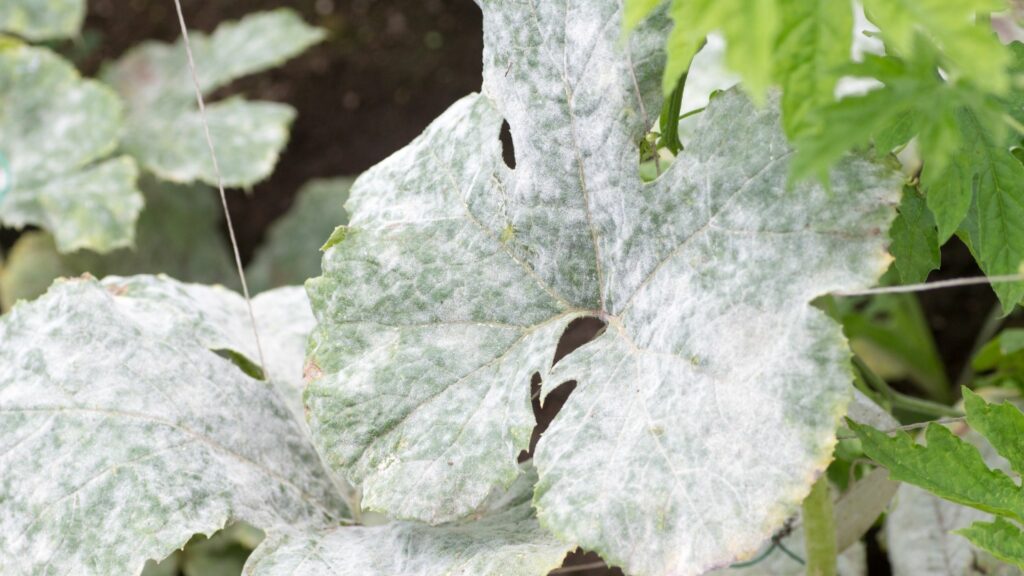Powdery Mildew
go.ncsu.edu/readext?933100
en Español / em Português
El inglés es el idioma de control de esta página. En la medida en que haya algún conflicto entre la traducción al inglés y la traducción, el inglés prevalece.
Al hacer clic en el enlace de traducción se activa un servicio de traducción gratuito para convertir la página al español. Al igual que con cualquier traducción por Internet, la conversión no es sensible al contexto y puede que no traduzca el texto en su significado original. NC State Extension no garantiza la exactitud del texto traducido. Por favor, tenga en cuenta que algunas aplicaciones y/o servicios pueden no funcionar como se espera cuando se traducen.
Português
Inglês é o idioma de controle desta página. Na medida que haja algum conflito entre o texto original em Inglês e a tradução, o Inglês prevalece.
Ao clicar no link de tradução, um serviço gratuito de tradução será ativado para converter a página para o Português. Como em qualquer tradução pela internet, a conversão não é sensivel ao contexto e pode não ocorrer a tradução para o significado orginal. O serviço de Extensão da Carolina do Norte (NC State Extension) não garante a exatidão do texto traduzido. Por favor, observe que algumas funções ou serviços podem não funcionar como esperado após a tradução.
English
English is the controlling language of this page. To the extent there is any conflict between the English text and the translation, English controls.
Clicking on the translation link activates a free translation service to convert the page to Spanish. As with any Internet translation, the conversion is not context-sensitive and may not translate the text to its original meaning. NC State Extension does not guarantee the accuracy of the translated text. Please note that some applications and/or services may not function as expected when translated.
Collapse ▲Powdery mildew is a common fungal disease that effects many different plants. The symptom of powdery mildew is a grayish-white, powdery mat visible on the surface of leaves, stems, and flower petals. Powdery mildew is not caused one specific fungus but the name given to a group of diseases caused by several closely related fungi. Even though this disease is not fatal, plant damage can occur when the infection is severe leading to reduced growth and flowering.
Life cycle and favorable conditions
As daytime temperatures rise above 60 °F, the fungi responsible for powdery mildew begin to produce spores, which are dispersed into the air. Infections occur when they contact a suitable host and environmental conditions are favorable. Initially symptoms are small, circular, powdery, white spots, which expand and eventually join as infections progress. Infections spread as spores produced in these white patches move by wind and splashing rain to other locations on the plant or nearby plants. The fungus overwinters attached to plant parts and plant debris, such as on fallen leaves. Then when spring comes and the weather warms, the process begins again.
Humidity is an important factor related to the onset and spread of powdery mildew. Unlike most fungi, these do not require free water to germinate; only a high level of relative humidity is required. High relative humidity favors spore formation. Low relative humidity favors spore dispersal.
Plants that commonly become infected with various powdery mildew include azalea, crabapple, dogwood, phlox, euonymus, lilac, snapdragon, dahlia, zinnia, crape myrtle, rose, pyracantha, rhododendron, spirea, wisteria, delphinium, oak, English ivy, photinia, blueberry, pecan, cucumber, and squash.
Management
As with all diseases, having a healthy plant is the first line of defense. One option for management is to tolerate the disease for example the infections don’t reduce plant growth and flowering. There are powdery mildew resistant varieties of some plants and if it is an issue in your landscape choosing one of them would help. Reducing humidity in the plant canopy can also help manage the disease. When planting, space the plants to allow adequate air circulation through them and prune to thin the foliage.
Don’t over fertilize plants, powdery mildew easily infects this lush growth that happens with to much nitrogen.
Lastly you can use fungicides, however they are rarely necessary. Fungicides should only be used to protect high-value plants that cannot be replaced and have a history of severe infection. For fungicides to be effective, they must be applied as soon as symptoms are noticed. Product labels will provide information on how often to spray, this is typically every 7 to 14 days. Look for fungicides labeled to control powdery mildew and follow the label.




